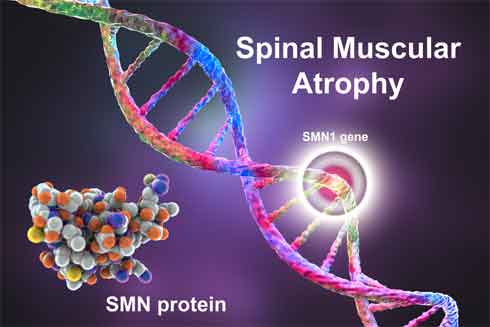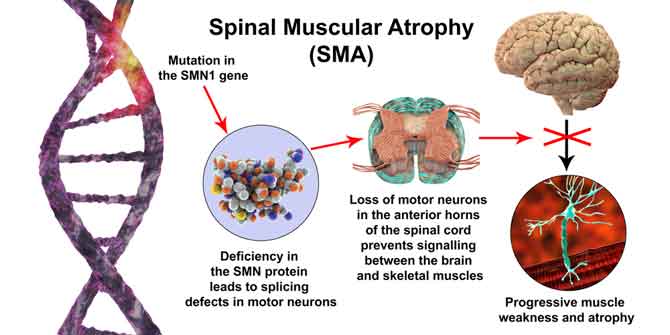A rare and debilitating condition, known as Spinal Muscular Atrophy (SMA), is an inherited disease that causes crippling consequences. It’s estimated that this condition affects about one in every 6,000 people. Due to the lack of the Survival Motor Neuron 1 (SMN1) loss of motor functions occurs. With this protein absent, the nerve cells within the spinal cord are unable to function correctly. This causes muscles to weaken and eventually cease to function.
There are three common forms of Spinal Muscle Atrophy: Type l, Type ll, and Type lll. A more rare form of SMA is Type lV, which only occurs in adults. The type of SMA a patient is diagnosed with depends on the age of the patient, as well as the on set of symptoms.
Symptoms of Spinal Muscle Atrophy

Numerous symptoms are associated with Spinal Muscle Atrophy. The most noticeable and debilitating symptom of SMA is loss of movement and muscle control due to the lack of proper function within the spinal cord. In some cases, decreased mobility may be only slight, but for more severe cases of SMA mobility can be severely limited. Symptoms usually begin as a slight decrease in the ability to stand and walk and eventually progress to full immobility. It is common for patients with SMA to suffer from respiratory conditions as well.
Diagnosing Spinal Muscle Atrophy
While the condition itself is complex, diagnosing Spinal Muscle Atrophy is relatively simple. A blood sample is collected and sent for laboratory testing to determine if there is a lack of or mutation of the SMN1 gene. In rare cases, a muscle biopsy may be conducted, as well as an electromyography (EMG). A muscle biopsy takes a sample of muscle tissue to be tested, whereas an EMG tests for electrical activity within the skeletal muscles.
Treatment for Spinal Muscle Atrophy
Sadly, there is no cure for Spinal Muscular Atrophy. The prognosis for patients with the condition is bleak because the bodies ability to use the muscles to continue properly breathing becomes limited, making premature death is common. The life expectancy for a patient with Spinal Muscle Atrophy varies form case to case and depends on the type of SMA. Some patients may only live for two years, but others with milder forms may live long lives with proper care, see more.
Care for SMA generally includes physical and occupational therapy, as well as respiratory therapy and nutritional support. With these treatment methods in place, the quality of life for a patient with SMA can improve greatly.
Respiratory therapy is a vital component for SMA treatment because respiratory complications and illness are the leading cause of death among patients with Spinal Muscle Atrophy. The goal behind respiratory therapy is to educate care givers with proper methods to reduce the risk of respiratory infection and illness, as well as maintain a clear airway.
Nutrition intervention is needed for SMA care, especially with children, because SMA patients are susceptible to either over eat or under eat. It is vital for children with SMA to be monitored properly to ensure they are growing and developing as normally as possible.
Physical and occupational therapy are important to reducing the progression of the disease and for improving a patients quality of life. These therapies will maintain the function of the body’s mobility as long as possible while promoting a patient with an adequate level of independence.
Currently, the Spinal Muscular Atrophy Project is underway, focusing on creating other therapies and treatments for SMA. This project conducts research about the condition, which includes creating drugs to promote the growth of the mutated or missing protein.
